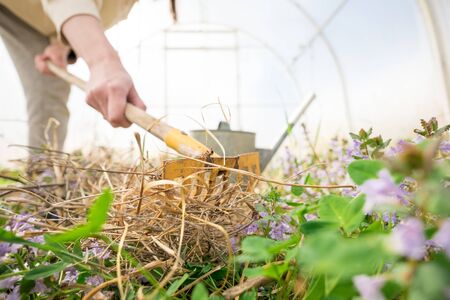1. Introduction to Fungal Pathogens in Plants
Fungal pathogens are microscopic organisms that cause diseases in plants. These fungi can infect a wide range of plant species, from vegetables and fruits to ornamental flowers and trees. In the United States, fungal plant diseases are a major concern for both commercial agriculture and home gardeners. Understanding what these pathogens are and how they affect plants is the first step toward managing them effectively.
What Are Fungal Pathogens?
Fungal pathogens are types of fungi that invade plant tissues, often leading to disease symptoms such as spots on leaves, wilting, mold growth, or even plant death. Unlike beneficial fungi that help with nutrient absorption or decomposition, pathogenic fungi harm their host plants by feeding on living tissues.
Why Do They Matter?
Fungal diseases can spread quickly and cause significant damage to crops and gardens. For American farmers, fungal infections can result in reduced yields and economic losses. Home gardeners may also find their flowers or vegetables failing due to an unnoticed fungal issue. Common culprits include powdery mildew, rusts, blights, and root rots.
Impact on U.S. Agriculture and Gardening
In the U.S., fungal pathogens are responsible for billions of dollars in crop losses each year. They affect everything from staple crops like corn and wheat to popular garden plants like tomatoes and roses. The table below highlights some common fungal diseases found across different regions:
| Fungal Disease | Affected Plants | Common Regions in the U.S. |
|---|---|---|
| Powdery Mildew | Roses, squash, cucumbers | Nationwide (especially humid areas) |
| Late Blight | Tomatoes, potatoes | Northeast and Midwest |
| Rusts | Corn, beans, ornamentals | Southeast and Central Plains |
| Root Rot (caused by Fusarium or Pythium) | Vegetables, houseplants | Areas with poor drainage or overwatering |
The Importance of Early Detection
Spotting the signs early—like yellowing leaves or fuzzy growth—can make all the difference in saving your plants. Whether youre growing food for your family or maintaining a backyard flower bed, being aware of fungal threats helps you act fast with treatments like fungicides or improved watering practices.
By learning more about how fungal pathogens live and spread (which well cover in upcoming sections), youll be better equipped to keep your plants healthy year-round.
2. Spore Germination and Initial Infection
Fungal pathogens begin their life cycle by producing spores, which are tiny reproductive units that can be carried by wind, water, insects, or even garden tools. Once these spores land on a suitable host plant under the right environmental conditions—typically warm temperatures and high humidity—they start to germinate. This is the first step toward infection.
How Spores Spread
Spores are highly adaptable and can travel long distances. In American gardens, common fungal diseases like powdery mildew in roses or rust in beans often spread through airborne spores. Splashing rainwater can also move spores from soil onto lower leaves of plants like tomatoes and squash.
Common Modes of Spore Dispersal
| Mode of Dispersal | Examples | Affected Plants |
|---|---|---|
| Airborne (Wind) | Powdery mildew spores | Roses, cucumbers, zinnias |
| Water Splash | Early blight spores | Tomatoes, potatoes |
| Insects | Sooty mold via aphids | Citrus trees, hibiscus |
| Contaminated Tools/Hands | Fusarium wilt spores | Basil, lettuce, petunias |
Spore Germination Process
Once a spore lands on a plant surface with enough moisture, it begins to absorb water and swell. It then produces a germ tube that grows toward the plants outer layer. Some fungi release enzymes that soften the plant tissue, making it easier for the germ tube to penetrate.
Factors That Promote Germination
- Moisture: Dew or rain provides necessary hydration.
- Temperature: Most fungal spores prefer temperatures between 65°F and 85°F.
- Host Susceptibility: Young or stressed plants are more vulnerable.
Initial Infection: Getting Inside the Plant
The germ tube either enters through natural openings like stomata (tiny pores) or directly penetrates the plant’s surface. Once inside, the fungus spreads by growing its hyphae—thread-like structures—that invade plant tissues and disrupt normal functions like water transport and photosynthesis.
Examples of Initial Infection in Common U.S. Garden Plants
- Downy Mildew on Basil: Spores settle on leaves during cool, moist evenings and infect through stomata by morning.
- Anthracnose on Beans: Enters through wounds or natural openings after heavy rain.
- Black Spot on Roses: Spores land during wet conditions and infect within hours if leaves remain damp.
This early stage of fungal infection is critical because it often goes unnoticed until symptoms appear days later. Understanding how spores spread and infect helps gardeners take timely action to prevent widespread damage.

3. Colonization and Disease Development
Once fungal spores land on a suitable host plant and conditions are right, they begin the process of colonization. This is when the fungus actually invades the plant tissue and starts to grow inside it. The way fungi enter the plant can vary—some penetrate directly through the plants outer surface, while others use natural openings like stomata or wounds caused by insects or weather damage.
How Fungi Establish Themselves
After entry, fungal pathogens produce thread-like structures called hyphae that spread through the plant’s tissues. These hyphae absorb nutrients from the plant cells, weakening the plant over time. Some fungi release enzymes that break down cell walls, making it easier for them to move deeper into the plant. Others form special feeding structures called haustoria that tap directly into plant cells.
Common Methods of Fungal Entry
| Entry Method | Description | Examples |
|---|---|---|
| Direct Penetration | Fungi push through the plant’s outer layer using pressure or enzymes. | Powdery mildew |
| Natural Openings | Fungi enter through stomata or lenticels (small pores). | Rust fungi |
| Wound Entry | Fungi take advantage of damaged tissue caused by pests or mechanical injury. | Botrytis (gray mold) |
Disease Symptoms and Impact on Plants
As the fungal pathogen spreads, it causes visible symptoms that can affect both appearance and productivity. Common signs include discoloration, wilting, leaf spots, and stunted growth. These symptoms vary depending on the type of fungus involved.
Examples of Common Fungal Diseases
| Disease Name | Main Host Plants | Typical Symptoms |
|---|---|---|
| Powdery Mildew | Cucumbers, roses, grapes | White powdery spots on leaves and stems; leaf curling; reduced fruit yield |
| Rust | Corn, beans, ornamental plants | Orange or brown pustules on leaves; premature leaf drop; reduced vigor |
| Downy Mildew | Lettuce, basil, grapes | Pale yellow spots on upper leaf surfaces; fuzzy gray growth underneath leaves |
Why Understanding Colonization Matters
The colonization stage is critical because its when the fungus truly becomes a threat to plant health. Knowing how fungi invade and spread helps gardeners and farmers choose effective management strategies before serious damage occurs.
4. Reproduction and Spore Dispersal
Fungal pathogens reproduce in several ways, and understanding these strategies is key to managing plant diseases in gardens, farms, and landscapes across the United States. Most fungal pathogens reproduce through spores, which can be produced sexually or asexually depending on the type of fungus and environmental conditions.
Types of Fungal Reproduction
Fungi use two main methods of reproduction:
- Asexual Reproduction: This is the most common method among plant pathogens. Fungi produce spores called conidia or sporangia that are genetically identical to the parent fungus. These spores are often released in large numbers, allowing rapid spread.
- Sexual Reproduction: In this method, fungi combine genetic material from two different mating types to form spores with new genetic combinations. These spores may be more resilient and better adapted to changing environments.
Spore Dispersal Mechanisms
Spores are tiny and lightweight, making them easy to spread through various natural and human-made processes. Heres how spores travel:
Wind
This is one of the most common dispersal methods for fungal spores. In dry and breezy regions like the Southwest or Great Plains, wind can carry spores over long distances. For example, powdery mildew and rust fungi rely heavily on air currents to reach new plants.
Water
In humid areas like the Southeast or Pacific Northwest, rain splashes and irrigation systems can move spores from soil or infected leaves onto healthy plants. Water molds (oomycetes), such as Phytophthora, often use water to infect roots and stems.
Human Activity
Spores can hitch a ride on gardening tools, clothing, vehicles, or even pets. In urban gardens or commercial farms, improper sanitation practices can unintentionally spread fungal diseases from one location to another.
Spore Dispersal Across U.S. Climate Zones
| U.S. Climate Zone | Main Dispersal Method | Common Pathogens |
|---|---|---|
| Northeast (Cool & Humid) | Rain Splash & Wind | Apple Scab, Downy Mildew |
| Southeast (Warm & Humid) | Irrigation Water & Human Activity | Pythium Root Rot, Southern Blight |
| Midwest (Seasonal Variability) | Wind & Water | Corn Rusts, Fusarium Wilt |
| Southwest (Hot & Dry) | Mainly Wind | Powdery Mildew, Sooty Mold |
| Pacific Northwest (Cool & Wet) | Mainly Water | Late Blight, Botrytis Blight |
| West Coast (Mild & Variable) | Irrigation Water & Wind | Antracnose, Black Spot |
Did You Know?
A single fungal fruiting body can release millions of spores into the air! That’s why early detection and proper garden hygiene are critical in preventing outbreaks.
If you live in a region with high humidity or frequent rainfall, consider spacing your plants well and using drip irrigation instead of overhead watering. This reduces moisture on leaves—one of the key ingredients fungi need to thrive.
The way fungal pathogens reproduce and spread varies widely depending on their biology and environment. By recognizing these patterns based on your local climate zone, you can make smarter decisions about plant care and disease prevention.
5. Management Strategies and Life Cycle Disruption
Breaking the life cycle of fungal pathogens is key to protecting your plants and ensuring a healthy garden. In this section, well explore practical, science-based methods used across the U.S. that help gardeners and growers interrupt the development and spread of fungal diseases.
Understanding the Fungal Life Cycle
To manage fungi effectively, its important to understand their life cycle. Most plant pathogenic fungi go through several stages: spore production, dispersal, germination, host infection, colonization, and reproduction. By targeting specific stages, we can limit or stop their ability to harm plants.
Integrated Pest Management (IPM)
Integrated Pest Management (IPM) is a holistic approach that combines different strategies to manage pests with minimal impact on people, pets, and the environment. For fungal pathogens, IPM includes cultural practices, biological controls, chemical treatments when necessary, and resistant plant varieties.
Cultural Control Methods
These practices aim to make the environment less favorable for fungal growth:
| Method | Description | Example |
|---|---|---|
| Crop Rotation | Avoid planting the same crop in the same spot year after year | Rotate tomatoes with legumes or leafy greens |
| Proper Spacing | Improves air circulation to reduce moisture buildup | Space plants according to seed packet recommendations |
| Irrigation Practices | Water at soil level and avoid overhead watering | Use drip irrigation systems |
| Sanitation | Remove infected plant debris promptly | Clean up fallen leaves in fall to prevent overwintering spores |
| Mulching | Prevents soil-borne spores from splashing onto plants | Apply straw mulch around vegetable plants |
Biological Controls
This involves using beneficial organisms to suppress fungal pathogens:
- Beneficial Fungi and Bacteria: Products like Bacillus subtilis or Trichoderma harzianum can be applied to soil or foliage.
- Compost Teas: Rich in microbial life that competes with harmful fungi.
- Nematodes: Certain beneficial nematodes may help reduce fungal populations in soil.
Chemical Controls (As a Last Resort)
If cultural and biological methods are not enough, fungicides can be used carefully:
- Copper-based fungicides: Effective against many common fungal diseases but must be applied before symptoms appear.
- Sulfur sprays: Useful for powdery mildew; avoid during hot weather to prevent plant damage.
- Bicarbonate solutions: A gentler option made from baking soda for minor infections.
Disease-Resistant Varieties
Selecting disease-resistant plant varieties is one of the easiest ways to prevent fungal issues. Many seed packets or nursery tags will list resistance codes for specific diseases such as Fusarium wilt (F), Verticillium wilt (V), or Powdery Mildew (PM).
Examples of Disease-Resistant Varieties Commonly Grown in the U.S.
| Crop | Disease Resistance Traits |
|---|---|
| Tomato (‘Celebrity’) | Fusarium wilt (F1 & F2), Verticillium wilt (V), Nematodes (N) |
| Cucumber (‘Marketmore 76’) | Downy mildew, Powdery mildew, Cucumber mosaic virus (CMV) |
| Zucchini (‘Raven’) | Powdery mildew resistance |
| Lettuce (‘Salinas’) | Lettuce mosaic virus resistance |
| Pepper (‘King Arthur’) | Bacterial leaf spot resistance (X10R genes) |
The Importance of Monitoring and Timing
The success of any management strategy depends on early detection. Regularly inspect your plants for signs of fungal disease—such as spots, wilting, or fuzzy growth—and act quickly. Applying treatments early in the pathogens life cycle is far more effective than waiting until symptoms are widespread.
A Layered Approach Works Best
No single method will completely eliminate fungal pathogens. Combining multiple strategies—like rotating crops, choosing resistant varieties, applying compost teas, and using mulch—creates an environment where fungi struggle to thrive. This layered defense is what makes Integrated Pest Management so effective for home gardens and farms alike across the United States.
Tackling fungi may seem overwhelming at first, but with consistent care and informed choices based on the pathogen’s life cycle, you can grow strong, healthy plants season after season.


